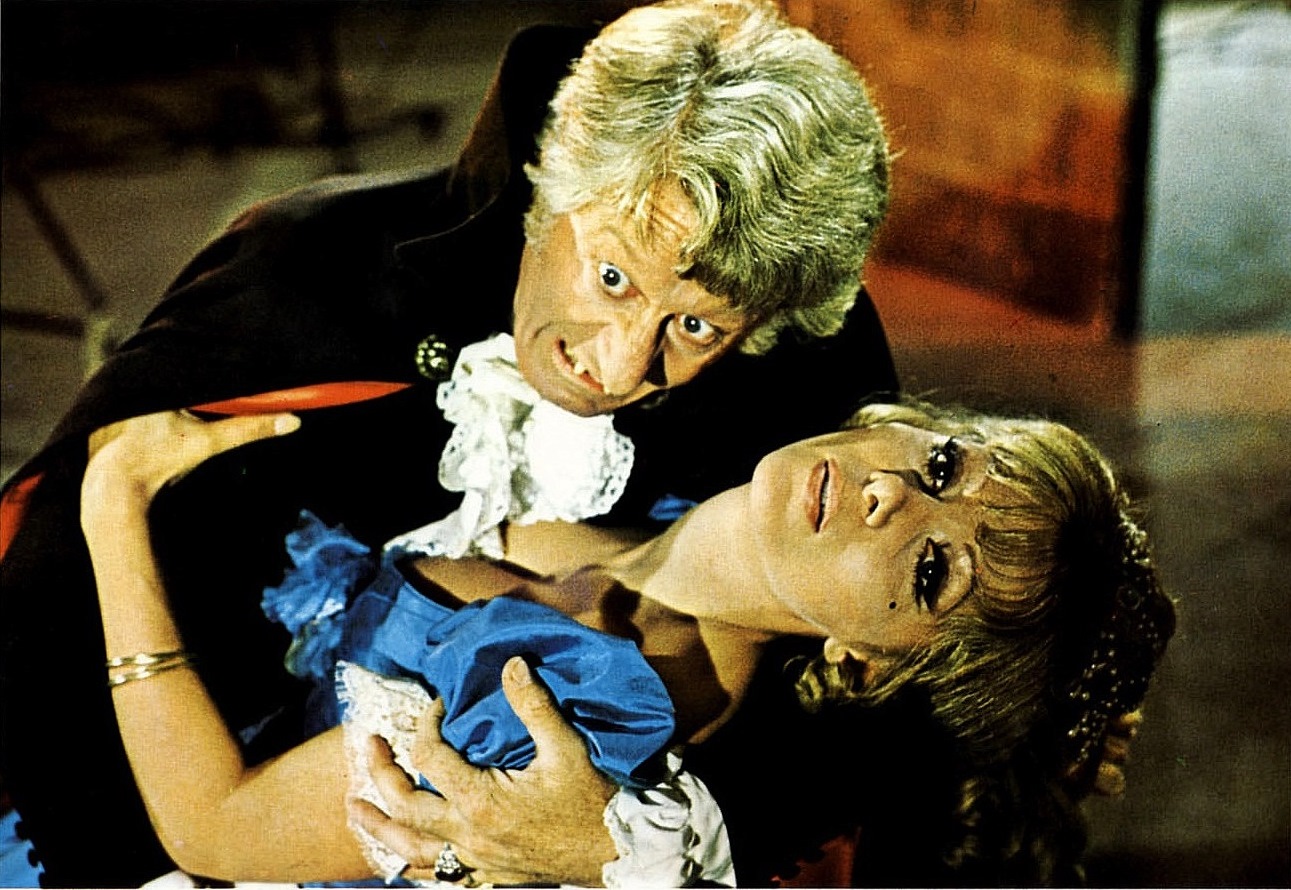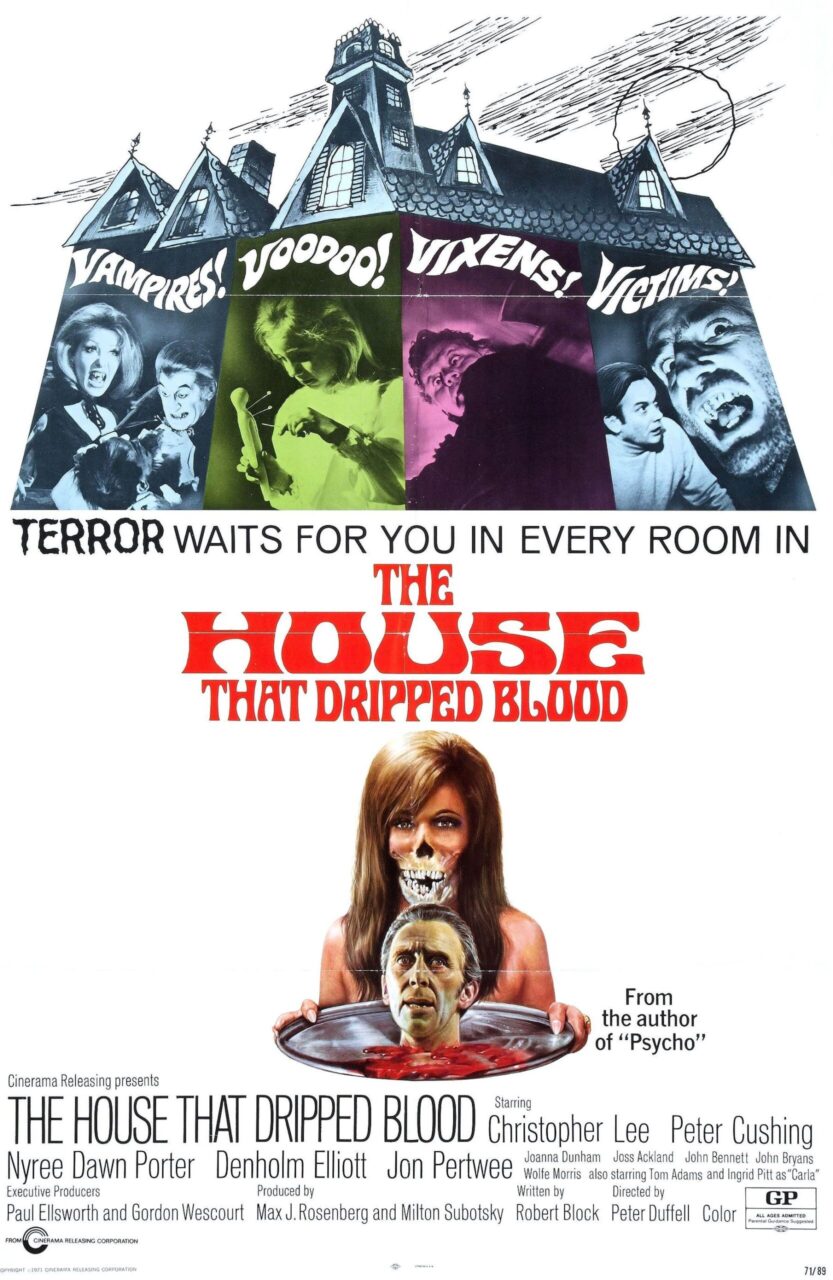Crew
Director – Peter Duffell, Screenplay – Robert Bloch, Based on his Short Stories, Producers – Max J. Rosenberg & Milton Subotsky, Photography – Ray Parslow, Music – Michael Dress, Art Direction – Tony Curtis. Production Company – Amicus.
Cast
Linking Story:– John Bennett (Inspector Holloway), John Bryans (Stoker), John Malcolm (Sergeant). Method for Murder:– Denholm Elliott (Charles Hillyer), Joanna Dunham (Alice Hillyer), Tom Adams (Dominick), Robert Lang (Psychiatrist). Waxworks:– Peter Cushing (Philip Grayson), Joss Ackland (Neville Rogers), Wolfe Morris (Proprietor). Sweets to the Sweet:– Chloe Franks (Jane Reid), Christopher Lee (John Reid), Nyree Dawn Porter (Ann Norton). The Cloak: Jon Pertwee (Paul Henderson), Ingrid Pitt (Carla), Geoffrey Bayldon (Count Von Hartmann)
Plot
A police inspector, searching for a missing horror film star, visits the house that the actor rented. There the realtor and a local police sergeant tell a series of stories about the house and the strange effect it has on the inhabitants. Method for Murder:– Horror writer Charles Hillyer creates the character of the strangler Dominick for his next book. However, Dominick then turns up for real and tries to strangle Hillyer’s wife – but she insists that it was Hillyer acting under subconscious compulsion. Waxworks:– Retired stockbroker Philip Grayson becomes obsessed with the exhibit of a beautiful woman in a wax museum and comes to realise that it may be the owner’s wife. Sweets to the Sweet:– John Reid hires Ann Norton as anew tutor by for his daughter Jane. Ann then discovers that Jane, who is harshly closeted by Reid, is taking revenge against her father using a voodoo doll. The Cloak:– The missing horror film actor Paul Henderson rents the house. Seeking authenticity in his next film, Henderson is given a cloak that was purportedly worn by a real vampire. However, when Henderson puts the cloak on it makes him fly, develop fangs and a thirst for blood.
Amicus Films were the most successful of the English companies during the 1960s and 70s to exploit the popularity that Hammer had had with their horror films. Amicus’s trademark became the horror anthology, beginning with Dr Terror’s House of Horrors (1965). (See below for Amicus’s other horror anthology titles). Amicus had employed Robert Bloch to adapt several of his stories for their second anthology Torture Garden (1967). They then adapted various other Bloch works and employed Bloch to write several original scripts. The House That Dripped Blood was their second anthology adapted from Robert Bloch’s work and they would again adapt an anthology of Bloch stories in Asylum (1972).
The House That Dripped Blood features a new debuting director in Peter Duffell, known for later works such as the appealing romantic comedy Experience Preferred … But Not Essential (1983) and the tv mini-series The Far Pavilions (1984) set during the British Raj. Perhaps as a debuting director, Duffell lacks the polish that Freddie Francis, the most prolific director of Amicus’s anthologies, brought. The stories are, as always, variable. The wraparound premise is much weaker than is usually the case with Amicus’s anthologies, while even the title seems more lurid than usual. Duffell is at least aided by a fine score throughout.

Method for Murder has a good idea and features Denholm Elliott restraining himself to reasonable effect. It ends on a decent double twist ending, even if it is one that totally defies logic. Waxworks is the slightest of the stories, only being lifted by the always-reliable presence of Peter Cushing. The best segment is Sweets to the Sweet, which is conducted with a certain degree of malice, particularly when it comes to Chloe Franks’ performance that swings between innocence and evil.
The Cloak is the segment that the film is always remembered for. It features Jon Pertwee, who would later that same year become the flamboyant Oscar Wildean third incarnation of Doctor Who (1963-89, 2005– ). The segment is clearly comic in tone – you can see the influence here that led to producer Milton Subotsky’s later entirely comic anthology The Monster Club (1980). However, Jon Pertwee, who up to that point was only known as a comedy actor, is hammy, while Peter Duffell seems undecided between whether he is conducting a serious episode or comedy and the humour falls rather limply.
Amicus’s other anthology films are:– Dr Terror’s House of Horrors (1965), Torture Garden (1967), Asylum (1972), Tales from the Crypt (1972), The Vault of Horror (1973) and From Beyond the Grave (1974).
Robert Bloch was most famous for writing the novel that became the basis of Psycho (1960). His other genre scripts are:- The Cabinet of Caligari (1962), Strait-Jacket (1964), The Night Walker (1965), The Skull (1965), The Psychopath (1966), The Deadly Bees (1967), Torture Garden (1967), Asylum (1972), the tv movie The Cat Creature (1973), the tv movie The Dead Don’t Die (1975), The Amazing Captain Nemo (1977) and an episode of Three Dangerous Ladies (1988?).


